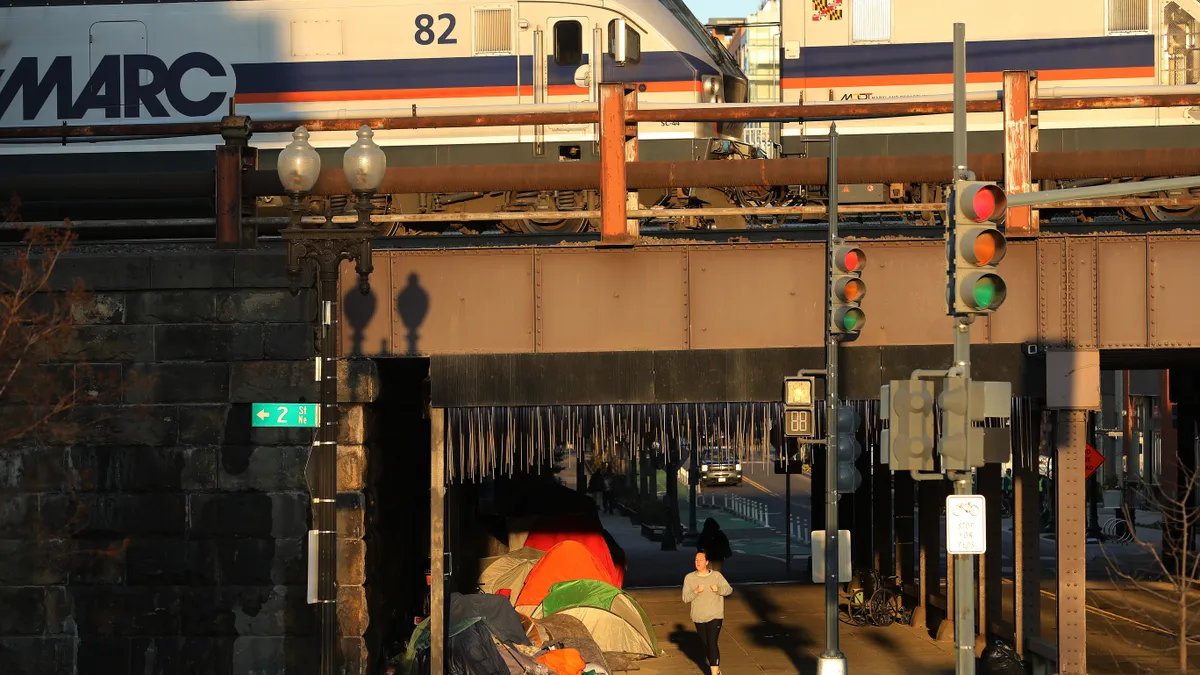Dive Brief:
- Ninety-four percent of families who participated in DC Flex, Washington, DC's flexible rent subsidy pilot program, generally were satisfied with it, according to a report from the Urban Institute and The Lab @ DC, a scientific team in the mayor's administration, which analyzed the first year of the "shallow subsidy" program. The report found that 88% of participants remained in stable housing and recertified for a second year with the program.
- In the first year, 60% of participants spent the full $7,200 they were allotted, and those who didn't were able to roll the remaining funds into their second year. The average DC Flex participant experienced a nearly 29% decrease in the use of homelessness services.
- "We know that there's a lot of jurisdictions that are really interested in this model," Sam Quinney, director of The Lab @ DC, said of the shallow subsidy approach, and little research exists on its ability to reduce homelessness and increase housing stability. "We're really hoping that other people will try it out, and we'll start to learn how it plays out with different housing markets and different government structures."
Dive Insight:
Shallow rental subsidies are considered an innovative approach to housing assistance and homelessness prevention for low-income households. The subsidies are called "shallow" because participants receive less funding than they would in other common housing-assistance programs, like rapid rehousing or permanent rental assistance. But shallow subsidies also provide participants with more flexibility than programs like housing vouchers.
In 2017, the Council of the District of Columbia allocated funding for the four-year DC Flex pilot program to test the effectiveness of a shallow subsidy program. Administrators deposited $7,200 into an escrow account for each of the 125 participating families at the start of the program year. The money could only be used on rent, but each family could decide how much of the money to use each month.
DC Flex participants have more autonomy and control over their finances than participants in traditional assistance programs, which typically direct a set amount of assistance to a landlord each month. The flexibility allows participants to balance their own budgets and manage their own finances in the way higher-income households do, Quinney said. For example, they decide how much subsidy or other income sources they can use to pay rent each month. In the focus groups the researchers conducted for the report, families reportedly said the program prompted them to examine how to establish credit, increase their credit scores and use banks rather than money orders to pay for rent.
"[Those are] some encouraging signs in terms of financial education and planning," said Josh Leopold, senior research associate at the Urban Institute. "It also is more transparent ... because the families know how much assistance they're going to get, and it's not going to fluctuate based on their income."
Overall, participants said they liked the program's flexibility and independence, although some said they would have benefited from case management to help with employment, financial decision-making and housing issues, the report stated. The program doesn't have extensive regulations, qualifications and progress-report requirements, Leopold said, making participation much less onerous. Plus, DC designed the program so that landlords don't necessarily know that renters received the subsidy, which can make them more attractive tenants and less likely to be victims of landlord discrimination, he said.
"I do feel like it's a promising model, and I like the idea of allowing families to choose for themselves and plan their own budgets," Leopold said. "I'd love to see other kinds of variations on this."
The report authors say they cannot yet draw firm conclusions about the program's effectiveness because they have only analyzed data from the program's first year, 2018-2019. They want to take more time to determine which elements work best and which could be tweaked in the future. For instance, organizers could better determine which families would most benefit from this program, and researchers could examine whether the funding is meaningful in assisting participants and more cost-effective for the city than other housing aid programs.
"You have to be thoughtful at the local level about how to design it so that it's going to be the most effective for the families you're trying to reach," Leopold said.
The Lab @ DC is analyzing results from DC Flex's second year (2019-2020), Quinney said. In future years, the researchers intend to examine additional housing stability and economic security indicators — including evictions, applications to other rental assistance programs and employment outcomes — and costs of the program relative to outcomes achieved. Plus, the next analysis will consider that the program's second year overlapped significantly with the start of the pandemic.
"That's going to complicate our analyses, and we're trying to figure out what's the best way to treat the pre- and during-pandemic periods," Quinney said.
Future analyses will influence whether DC leaders choose to continue the program after the four-year pilot period.
"What I see from this first year is that it's a program that is functioning the way we wanted it to, and the program designers wanted it to, and that it's serving as a viable model for many families," Quinney said. "We'll have to look longer term to see whether or not those families wind up better or worse off [than] the status quo in terms of their housing stability and other outcomes."
At 125 families, the pilot program sample size is rather small, Quinney added. Organizers hope other cities try similar programs and share their data.
"It's really never completely definitive until you get really large bodies of research on it. I would love to see our results paired with the results from a similar model that's been rigorously tested in another jurisdiction to really say definitively whether DC Flex is a viable viable model for housing subsidies," Quinney said. "I think we'll have a better idea after two years."












